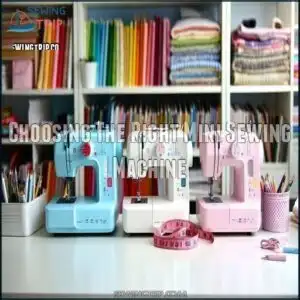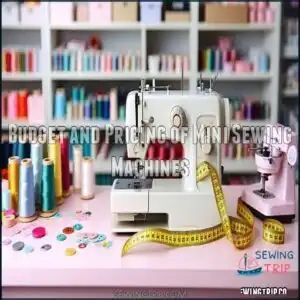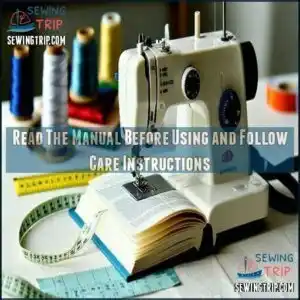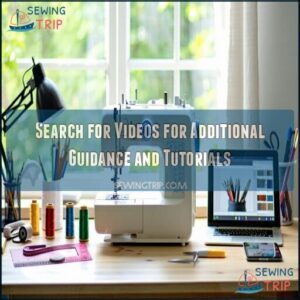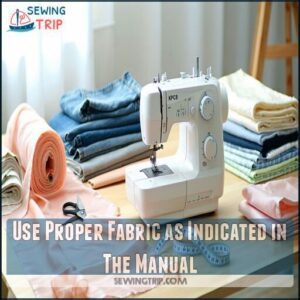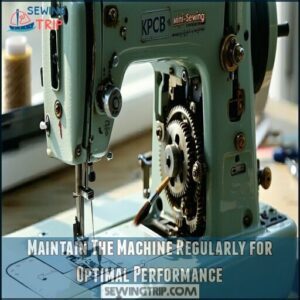This site is supported by our readers. We may earn a commission, at no cost to you, if you purchase through links.
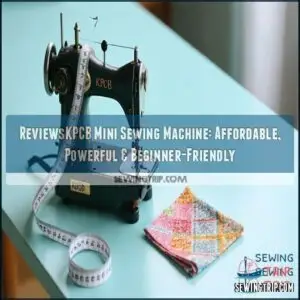 The KPCB Mini Sewing Machine is a solid choice if you’re looking for something compact, affordable, and easy to use.
The KPCB Mini Sewing Machine is a solid choice if you’re looking for something compact, affordable, and easy to use.
It’s great for beginners or casual sewers tackling light projects like hemming pants or stitching patches.
The reverse sewing function is a handy feature to keep your seams secure, and the low noise level makes it perfect for quiet environments.
While it’s not ideal for heavy fabrics or large projects, it’s reliable for quick fixes or creative hobbies.
Plus, its lightweight design means you can store it easily or even take it on the go.
Need maintenance tips? Keep reading!
Table Of Contents
Key Takeaways
- You’ll find the KPCB Mini Sewing Machine ideal for beginners and casual sewers with its compact design, affordable price (under $100), and easy-to-use features like the reverse sewing function.
- Don’t expect it to handle heavy fabrics or large projects—it’s best suited for light materials, quick fixes, and basic creative projects.
- You can extend your machine’s lifespan by following the manual’s instructions, regularly cleaning out lint, proper lubrication, and watching tutorial videos for maintenance tips.
- You’ll appreciate its low noise level for quiet environments, though some users report vibration issues that can be minimized by placing the machine on a stable surface or using a neoprene mat.
Choosing The Right Mini Sewing Machine
Choosing the right mini sewing machine can seem tricky, but it’s all about matching the machine to your goals.
Think about what you’ll sew most often, how much noise you can handle, and whether features like reverse sewing will make your projects easier.
Determine Your Sewing Needs and Frequency of Use
Choosing the best mini sewing machine, like the KPCB Mini Sewing Machine, starts with your sewing goals.
Your perfect mini sewing machine depends on your sewing goals—whether it’s quick fixes or creative projects, pick what fits you best.
Do you need a beginner sewing machine for quick fixes, or are you diving into creative projects with complex fabrics? Knowing your skill level, project complexity, fabric types, and how often you’ll sew helps narrow it down.
- Tip: If space constraints matter, compact machines work great!
A sewing machine for beginners should handle basic tasks easily while being user-friendly. Be realistic about your needs to find the perfect match!
Check The Machine’s Noise Level and Vibration
When picking the right sewing machine, consider how noise and vibration will impact your experience.
The KPCB Mini Sewing Machine gets mixed reviews here. Some say it hums pleasantly with low noise, while others liken its motor sound to a tiny jackhammer.
Lightweight machines like this can vibrate more, especially on uneven sewing surfaces.
Noise dampening tricks like placing a neoprene mat under it or sewing on stable furniture help reduce vibration and improve user perception.
While its build feels sturdy for beginners, prolonged use might reveal motor instability. If you’re sensitive to sound or plan to sew quietly at night, be sure to check detailed sewing machine reviews beforehand to ensure a suitable choice for your needs, considering factors like prolonged use and sewing machine reviews.
Reverse Sewing Function for Securing Seams
A strong seam makes all the difference, right? The reverse sewing function on the KPCB Mini Sewing Machine guarantees your stitches stay durable and intact.
By stitching backward, you can reinforce seams to prevent unraveling, especially on fabrics prone to wear. Don’t skip this step—it’s like tying a knot at the end of your thread!
To prevent issues, confirm regular machine cleaning is performed.
- Adds seam reinforcement for extra strength.
- Perfect for securing ends and preventing unraveling.
- Boosts stitch durability and professional finish.
- Works well with light to medium fabric compatibility.
- Function limitations might struggle with heavy fabrics.
Budget and Pricing of Mini Sewing Machines
You don’t have to spend a fortune to enjoy sewing with a mini machine.
Many models, like the KPCB Mini Sewing Machine, offer great features for under $100, and bundle deals can stretch your dollar even further.
Affordable Prices Under $100 or $200 for Basic Models
Finding a mini sewing machine under $100 might seem tricky, but it’s all about the price-performance ratio. Many affordable sewing machines, like the KPCB Mini Sewing Machine, offer solid features without breaking the bank.
Check trusted marketplaces for the best sewing machine price and compare options for quality and value. Don’t ignore refurbished options—they’re like hidden gems, saving you money while maintaining good functionality.
You can find similarly priced laptops under $200 at major retailers. Watch for seasonal discount timing too.
Affordable sewing machines are proof you don’t need to overspend for results!
Look for Bundle Deals or Starter Kits With Accessories
Jumpstart your sewing journey with bundle deals or starter kits packed with accessory value and convenience.
Bundle deals offer everything you need to sew confidently, saving time, money, and hassle—perfect for beginners and pros alike!
Many beginner bundles for the KPCB Mini Sewing Machine include starter kit essentials like fabric bundles, needle sets, and extra thread options.
These all-in-one packages save you time, money, and effort, so there’s no need to hunt down individual sewing machine accessories. Plus, they give you everything you need to get started confidently.
Thinking ahead? Bundle deals make your first stitches hassle-free! Some kits even include machines with a useful automatic needle threader.
Consider Refurbished or Certified Pre-Owned Mini Sewing Machines
A refurbished or certified preowned mini sewing machine can offer cost savings without skimping on quality.
To make a smart buy, focus on these tips:
- Warranty Coverage: Check if the machine includes a warranty or return policies.
- Inspection Process: Verify the machine has been inspected and repairs made if needed.
- Machine History: Confirm details about prior use or defects.
- Price Comparison: Compare refurbished options to new models.
Sewing machine reviews can help guide your choice.
Think of it as treasure hunting—quality gear at a bargain price!
Check for Discounts, Promotions, or Sales During Holiday Seasons
Holiday sales are goldmines for budget shopping on mini sewing machines.
Retailers ramp up seasonal promotions, offering discounts and bundles that stretch your dollar. Sign up for newsletters to catch early deals, or track prices like a hawk.
- Set alerts to snag bargains on the KPCB Mini Sewing Machine.
- Combine coupons with holiday sales for double the perks.
- Time purchases around big events like Black Friday or Cyber Monday.
Compare Prices Across Online Marketplaces and Retailers
You don’t have to pay full price for a KPCB Mini Sewing Machine if you shop smart.
Compare prices on online marketplaces like Amazon vs. Walmart to spot bargains. eBay alternatives can also surprise you with deals, often featuring free shipping.
Use price tracking tools to monitor discounts during a sewing machine sale, and don’t forget to check for coupon availability!
Refurbished value machines might save you extra cash without sacrificing quality.
Keep tabs on sewing machine price trends and explore sewing machine deals for bundles that include useful accessories—it’s worth the effort.
Tips for Using and Maintaining Your Mini Sewing Machine
Taking care of your mini sewing machine doesn’t have to be tricky if you stick to a few simple habits.
Read the manual, keep it clean, and use the right materials to keep everything running smoothly.
Read The Manual Before Using and Follow Care Instructions
Don’t skip the user manual—it’s your sewing machine’s best friend! It’s packed with tips on setup, fabric compatibility, and safety precautions.
Follow care instructions to avoid jams and guarantee smooth use. Pay special attention to the troubleshooting guide and regular maintenance tips to keep your KPCB Mini Sewing Machine running like a charm.
Many users find that sewing machine repair can be avoided with proper care.
- Pro Tip: Keep the manual handy!
Search for Videos for Additional Guidance and Tutorials
Stuck threading the needle or winding a bobbin? Don’t worry—tutorial videos can save the day!
From threading tutorials to project examples, YouTube and online classes are loaded with sewing techniques for the KPCB Mini Sewing Machine.
These sewing tutorials are visual goldmines, offering everything from bobbin winding to stitch techniques.
Whether you need a quick fix or step-to-step guidance, there’s a video for you.
Maintenance videos and troubleshooting clips are especially helpful when things don’t go as planned.
So, grab your machine, plunge into those resources, and let creativity take the wheel!
Use Proper Fabric as Indicated in The Manual
Picking the right fabric makes using your KPCB Mini Sewing Machine a breeze. These compact machines excel with light- to medium-weight materials. Avoid tackling thick or stretchy fabrics—they can cause jams and headaches!
- Check Fabric Compatibility: Stick to basic fabrics your manual approves.
- Adjust Needle and Stitch Settings: Match the needle type and stitch to your material.
- Mind Fabric Layers: Limit layers to avoid overwhelming the machine.
For the best results, consider exploring different KPCB fabric options. Keep it simple, and you’ll sew smoothly!
Maintain The Machine Regularly for Optimal Performance
Keeping your KPCB Mini Sewing Machine in top shape is a breeze with consistent sewing machine maintenance. Start with regular lint removal to stop fabric fuzz from jamming the works.
Don’t forget sewing machine lubrication—just a few drops go a long way. To keep your machine running smoothly, consider a professional servicing annually.
Check bobbin tension for even stitching and replace needles often to avoid frustration.
| Task | Frequency | Tip |
|---|---|---|
| Lint Removal | After every use | Use a mini vacuum. |
| Oiling Mechanisms | Monthly | Avoid over-oiling. |
| Belt Inspection | Every 6 months | Look for frays or wear. |
Frequently Asked Questions (FAQs)
Are mini sewing machines worth it?
Mini sewing machines are worth it if you’re starting out or need quick fixes.
They’re portable, affordable, and beginner-friendly, but don’t expect them to tackle heavy fabrics or complex projects—think light sewing tasks only!
How much does a craftbud mini sewing machine cost?
Imagine grabbing a coffee for the price of a CraftBud mini sewing machine—it typically costs between $40 and $60 online. Prices vary by retailer, so keep an eye out for deals!
Can a craftbud mini sewing machine run on batteries?
Yes, your CraftBud mini sewing machine can run on batteries, making it perfectly portable for on-the-go projects. You’ll find this feature especially helpful when you’re crafting away from power outlets.
What is the Best Mini sewing machine?
You’d think all tiny stitchers were created equal, but they’re not.
The KPCB mini sewing machine stands out with its 12 stitch patterns, double thread capability, and beginner-friendly design that won’t break the bank.
Is craftbud a good sewing machine?
CraftBud offers decent quality for beginners with helpful features like dual speed settings and an extension table.
You’ll appreciate the included guidebook, but watch out for potential threading issues and occasional jamming.
Is mini sewing machine worth buying?
Mini sewing machines are worth buying if you need something portable, affordable, and simple for basic projects.
You’ll appreciate their compact size for small spaces, though they can’t handle heavy-duty work.
What is the disadvantage of a mini sewing machine?
While compact size is appealing, mini sewing machines can’t handle thick fabrics, have limited stitch options, less power, and may jam frequently.
They’re better for occasional small projects than regular use.
Which sewing machine has the least problems?
Based on reviews, the KPCB Mini Sewing Machine appears to have fewer issues compared to other mini machines.
You’ll appreciate its reliability for basic projects and repairs despite its limitations with thicker fabrics.
Who makes the Aldi sewing machine?
You’ll find that Aldi’s sewing machines are manufactured by different companies.
Some sources indicate they’re made by Janome, while newer models under the Ambiano brand name are manufactured by various suppliers for Aldi’s private label.
What is the disadvantage of mini sewing machine?
You’ll find mini sewing machines struggle with thick fabrics, have limited stitch options, and lack power for complex projects.
They’re also less durable and may have responsive pedal issues during extended use.
Conclusion
Like a reliable friend in your crafting corner, the KPCB mini sewing machine delivers impressive performance without breaking the bank.
You’ll appreciate its portable design for quick fixes and light projects.
It’s not for heavy-duty work, but you can’t beat the value for everyday sewing tasks.
With proper care and maintenance, your machine will serve you well for years.
Check reviews KPCB mini sewing machine listings online—you might snag one at an even better price!
- https://thereviewindex.com/us/p/KPCB_Mini_Sewing_Machine_with_Upgraded_Eco_Friendly_Material/AZ-US_B07GX87P1K
- https://www.walmart.com/ip/KPCB-Tech-Mini-Sewing-Machine-with-Extension-Table-and-42-PCS-Sewing-Kits/518680435
- https://reviewmeta.com/brand/kpcb-tech
- https://www.yours.co.uk/leisure/crafts/kpcb-tech-mini-sewing-machine-review/
- https://www.youtube.com/watch?v=vwsGEnQnAKc

